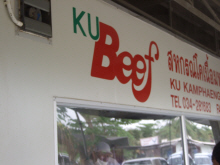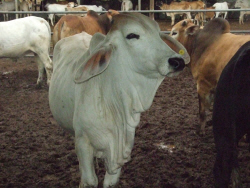



Thais Aim to Boost Beef Production
According to the Department of Livestock Development (DLD), Thailand had in the region of 9.1 million beef cattle in 2008. Imported breeds include Brahman, Charolais, Blonde d’ Aquitaine and Angus, writes Stuart Lumb for TheCattleSite.Beef imports were boosted following the signing of a free trade agreement (FTA) between Thailand, Australia and New Zealand in 2005, with Australia being the major supplier as opposed to New Zealand. Other major exporters to Thailand are the US, the EU (Netherlands, Italy and Germany) and Brazil. DLD data shows that Thailand imported 1581 tonnes of beef valued at Thai Baht 170.85 million in 2005, 1842 tonnes valued at THB 225.65 million in 2006 and 1921 tonnes, THB 310.9 in 2007.

TheCattleSite
Sunthorn Farm is situated in Kanchanaburi province in the western part of Thailand and it’s goal is to increase the production of premium beef in Thailand. This is because beef produced from traditional native Thai breeds is tough and lacks eating quality.
Premium beef accounts for only about 1 per cent of the beef produced in Thailand. It is beef produced from cattle that are crosses between imported and native breeds. The premium beef female lines are derived from Brahman and native breeds crossed with imported breeds such as the Charolais.
Second grade beef has a market share of 49 per cent and third grade 50 per cent.
The second grade beef is sourced from two-way crosses, mainly Brahman and native breeds whilst the third grade comes from breeds such as the Brahman and other individual native breeds.
Sunthorn Farm is determined to boost the production of premium beef in order to compete with the imported beef that is dominating supplies to the top end supermarkets, restaurants, hotels and caterers in Thailand.
Sunthorn Farm is stocked with a three-way cross developed by Kasetsart University at their Kampangsean Campus. The cross has actually been fixed as a breed and is named after the campus, with the beef being marketed as “Kampangsaen Beef.”

TheCattleSite
The Kampangsean breed is a cross between a Thai native breed and Brahman bloodlines. It is then crossed with Charolais to produce the slaughter generation. The university has its own slaughter house and butcher’s shop which supplies beef to university staff and visitors to the university. According to Mr Sunthorn, whilst the Kampangsean beef does not match the quality of the top imported beef it is being increasingly sought after by supermarkets and caterers. Significantly Thai Airways are now a well established customer.
Sunthorn Farm in addition to breeding its own Kampangsaen cattle supplies semen and heifers to farmers to produce their own Kampangsaen cattle. Sunthorn Farm also breeds Brahmans and native Thai breeds and produces F1 crosses based on these 2 breeds.
Semen is imported from three sources by Sunthorn Farm to use on its own females, plus Sunthorn distributes semen throughout Thailand . The breeds imported are:
- Charolais and Blonde d’ Aquitaine from Sersia, France
- Angus from CRI, USA
- Simmental from Semex, Canada
At birth, calves are weighed, breeding details are recorded, ear-tagged and vaccinated against foot-and-mouth disease. Blood samples are taken at six months for brucellosis and bovine tuberculosis testing and thereafter annually. Worming and FMD vaccination takes place twice a year.
After weaning, the calves are moved to the grow out unit. They are fed concentrates, grass and corn silage. There are 25-30 calves in each group.
Heifers are selected at 12 months of age for either breeding or finishing. Complete feed is given ad lib during finishing and slaughter takes place at 22 months of age. All the cows are registered with the Kampangsaen Cattle Cooperative , plus the coop stores all the animal records. Each cow is monitored with regard to health issues by farm vets and all data is recorded for traceability purposes.

TheCattleSite
Increasing the production of premium beef in Thailand is an opportunity to eventually boost semen imports. The trend has been in the opposite direction in recent years, as data indicates. Statistics from DLD showed that Thailand imported 187,567 doses of beef breed semen in 2005 worth THB 20 million, 135,447 doses in 2006 worth THB 34.35 million and 51,070 million doses in 2007 worth THB 15.16 million.
Imports then decreased dramatically to 21,383 doses valued at THB 5.98 million in 2008.
The plunge in semen imports is a direct reflection on increasing imports of beef. In 2008, beef imports into Thailand doubled to 3,637 tonnes, worth THB 622.277 million.
To become more self sufficient and to cut beef imports, the government, through the DLD, has initiated several quality beef cattle breeding projects.
One of them is a project located in the northern province of Talk. The DLD has developed a breed called the “Tak ” named after the province where the breeding station is located.
The Tak breed has been developed from the American Brahman and Charolais breeds. American Brahman and Charolais females (50:50) are bred and these are then inseminated with American Brahman to produce a 75 per cent American Brahman and 25 per cent Charolais cross.
After this, the 75 per cent AB : 25 Ch crosses are inseminated with Charolais semen, the resultant cross being 62.5 per cent Charolais: 37.5 per cent American Brahman.
The breeding station distributes Tak semen (62.5 per cent Charolais and 37.5 per cent American Brahman) which local farmers then use on their native Thai cows.
The DLD said the Tak breed adopts well to local farming conditions and feeds, whilst in addition is fast-growing and has meat with a high percentage of marbling fat.
Another DLD project involves the development of a dual purpose breed called the “Kabinburi”, which is a cross based on Brahman female lines crossed with German Simmental (semen). The station then sells Kabinburi heifers and semen to local beef farmers.
Similar breeding programmes such as the Tak and Kabinburi ones are being developed in Thailand both by the government and the private sector.
June 2009


